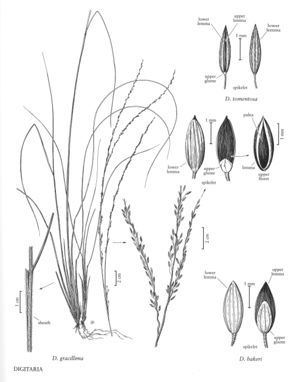Digitaria gracillima
Plants perennial; in dense tufts, not rhizomatous. Culms 60-100 cm, erect. Sheaths villous, particularly the lower sheaths; ligules 0.2-0.4, fimbriate; blades to 47 cm long, 1-2.1 mm wide, involute, glabrous and smooth abaxially, scabrous adaxially, sometimes with a few long hairs near the base. Panicles of 2-3 (5) spikelike primary branches on elongate rachises; primary branches 8-13 (20) cm, narrowly winged, wings no more than 1/2 as wide as the midribs, bearing spikelets in unequally pedicellate groups of 3-4 (5); secondary branches rarely present; longest pedicels to 5 mm. Spikelets 1.7-2.3 mm, elliptical, glabrous. Lower glumes absent; upper glumes 0.9-1 mm, less than 1/2 as long as the spikelets, 3-veined, glabrous, broadly rounded to truncate; lower lemmas slightly shorter than the spikelets, 5-veined, glabrous; upper lemmas smooth, brown when immature, dark-brown at maturity. 2n = unknown.
Discussion
Digitaria gracillima is a rare species, endemic to scrub and dry pinelands of peninsular Florida. It was formerly interpreted as including D. bakeri, but differs from that species both morphologically and ecologically.
Selected References
None.
Lower Taxa
"decumbent" is not a number.
